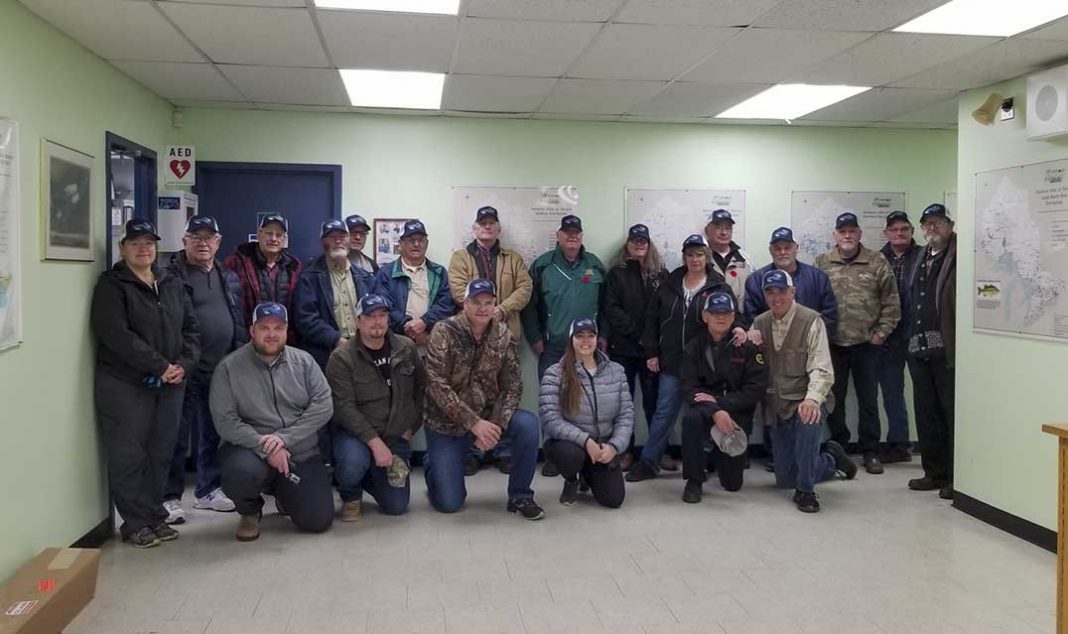SHEGUIANDAH – The Howland Seniors’ Hall was packed with an elite group of conservation volunteers last week, as Matt Burley of the Ontario Conservation Centre and the Ontario Federation of Anglers and Hunters (OFAH) brought presentations on the best practices of the Community Hatchery Program (CHP) in raising muskellunge and walleye.
The CHP seminars were hosted by the Little Current Fish and Game Club (LCFGC) and representatives of the Almaguin Fish Improvement Association Learning Centre, Baldwin Cottagers Association Rearing Ponds, Chelmsford Fish and Game Association, Gore Bay Community Fish Hatchery, Little Current Fish and Game Club, Temagami and Area Fish Improvement Program, Webbwood Hatchery and the Whitefish Falls Sportsman Club packed the hall.
“This is a great opportunity to get us all together in one room so we can hopefully help solve any problems that any of us are having, come up with solutions together and so on,” said LCFGC president Bill Strain.
“As is often the case, you get into the open forum with the different clubs after the presentations where you can ask questions and learn how other clubs have dealt with the issues you are facing,” agreed Gore Bay Fish and Game Club member Ian Anderson.
“Running a community fish hatchery isn’t easy,” noted Mr. Burley. “Raising fish is not only time consuming, but the high costs of energy bills, feed and equipment can make community hatcheries very expensive to operate and that’s where the value of an initiative like the CHP comes in. With an increase in application dollars requested each year, some of the nearly 43 community hatcheries operating in Ontario would find it challenging to remain operational without the support of the CHP funding partnership.”
Before gathering in the Howland Seniors’ Hall, the hatchery operators toured the Ministry of Natural Resources Blue Jay Creek Hatchery and, following lunch and presentations at the hall, they toured the LCFGC operation and the club’s fish viewing stand on Bass Creek.
The CHP was launched by the OFAH in partnership with the Ontario Ministry of Natural Resources and Forestry (MNRF) in March 2013 to provide a funding conduit “to support eligible community hatcheries and provide strategic and targeted support for Ontario’s community fish culture and stocking efforts.” The program acknowledges the critical role of the thousands of dedicated volunteers in improving Ontario’s fisheries and to educate people about the role that stocking plays in those efforts.
Community-based fish culture is built “on a foundation of passion, dedication and genuine concern for resource management,” noted Mr. Burley, who brought along two videos demonstrating the disinfection and transportation methods that comprise best practices in the industry. “Their motivations are the same, they all want to conserve local fisheries and stock fish to support fishing opportunities through put-grow-take fish stocking programs, rehabilitate native fish populations and conserve local genetic strains.”
Community hatcheries also double as education centres, of which the LCFGC operation in Sheguiandah which sees literally hundreds of young students each year, is a standout example. Each year the club not only educates Island students about the importance of conservation and the intricacies of the walleye life cycle and habitat, but provides the students with their very own fishing rod and reel to take home with them.
There are nearly 50 community hatcheries operating throughout the province each year, and a sizable number of those hatcheries were represented at the Community Hatchery Program seminars. Mr. Burley noted that the MNRF operates nine provincial fish hatcheries that stock approximately eight million fish into over 1,200 Ontario water bodies each year. “Ontario’s community hatcheries complement the MNRF’s stocking efforts by raising and stocking additional fish each year,” he said. The species being stocked include: Atlantic salmon, brook trout, brown trout, Chinook salmon, Coho salmon, lake trout, muskellunge, rainbow trout and walleye.
Community hatcheries raise and stock millions of fish into nearly 100 Ontario lakes and rivers and since 1982, community hatcheries have collectively stocked over 235 million fish into public waters. That work takes considerable time and effort, and community hatchery volunteers spend nearly 70,000 hours annually in their fish raising and stocking efforts. The most commonly stocked species is walleye, and that is where the LCFGC efforts are focused.
Community hatcheries play a vital role in preserving and reintroducing native species, such as those working to rebuild the Lake Ontario Atlantic salmon or the efforts of one hatchery in conserving the unique lake trout strain known as Haliburton Gold. In fact, all of the Coho salmon and Chinook salmon stocked into the Ontario water of Lake Huron have been raised by community hatcheries.
So the next time you toss a line into Manitoulin Island’s waters, spare a thought for the dedication, passion and hard work of the folks who quite likely raised and stocked that fish you are trying to land.
“If you are feeling like doing some work, the extra hands will always be welcome,” laughed Mr. Strain. “Old guys like me are getting up there.” But to help support the efforts of the Island community hatcheries with a financial contribution you can contact Lynn Hughson, treasurer of the LCFGC, or Chris Robinson, president of the Gore Bay Fish and Game Club.
“It costs a lot for gas for the generators and soymeal for the fish feed,” said Mr. Strain. “Add in the cost of electricity and feeding the fry until they get to a good size to survive, it can really add up,” agreed Mr. Anderson. “We are all really small clubs and we will take all the help we can get.”





